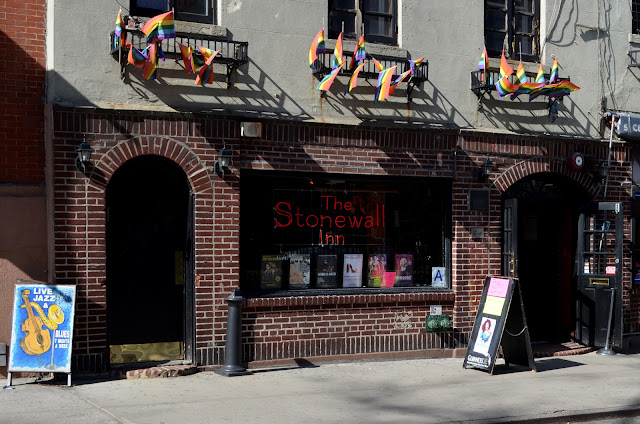With this entry, I'll begin at the northeast corner of W. Houston Street and LaGuardia Place, where there is a large lot (25' x 40' / 7.6 x 12m), which was turned into, what artist Alan Sonfist calls, "land artwork". Titled Time Landscape, the garden plot consists only of plants which are native to the island, and is meant to give New Yorkers a view of what the area looked like before the Colonists' arrival.
First proposed in 1968 by Sonfist, with the essay "Natural Phenomena as Public Monuments", the project was publicly unveiled in 1978. As you walk north along LaGuardia Pl, you can spot birch trees, beaked hazelnut shrubs, red cedar, black cherry, witch hazel, mugwort, Virginia creeper, aster, pokeweed, milkweed, oak trees, white ash, American elm trees, sassafras, sweetgum, tulip trees, arrowwood, dogwood shrubs, bindweed, catbrier vines, and violets - all planted by the artist.
When you approach Bleecker Street, begin walking westward, and you will come to the corner where Bleecker crosses 6th Street, Downing Street, and Minetta Street. Turn right on Minetta St to experience the complete opposite of Time Landscape, as this street runs over what once was Minetta Creek, a stream that was one of the largest natural waterways in Manhattan, only to be covered up.
The name is derived from what the local Native American's called it, Manette, which translates as "devil's water". Some say the creek still runs under the streets of Manhattan, while others claim the construction completely stopped its flow.
At the end of Minetta Street, make a right, and you'll almost immediately find yourself in front of one of the most happening spots in Beat and Hippie history: Cafe Wha?.
Opening in 1959, and closing sometime in the mid-60s, the joint was bought by club manager, and uncle to David Lee Roth, Manny Roth. It became a popular hangout for comedians, musicians and hipsters, such as Bob Dylan, Jimi Hendrix, Bruce Springsteen, The Velvet Underground, Woody Allen, Lenny Bruce, Bill Cosby, and Richard Pryor.
Roth sold the place in 1968 to Menachem Dworman, who ran it as Cafe Feenjon, changing the style from Beat poetry, and rock-n-roll, to falafels, and Middle Eastern music, until 1987, when Dworman's son Noam changed it back to its original name, and brought back the rock.
Head back to Bleecker St, and walk east to Wooster Street, where you'll find the Silver Towers Complex. Within their courtyard stands a huge (67 ton), two-sided, concrete sculpture of Picasso's 1954 "Bust of Sylvette" (originally inspired by beautiful 19-year-old Sylvette David).
While many think this 1968 installation is by Picasso himself, the truth is he didn't have much to do with it. It turns out that Picasso doesn't have any outdoor sculpture in the U.S., besides his 50' (15m) / 140 ton piece in Chicago. The work is actually by Norwegian sculptor Carl Nesjar, who only asked Picasso (by mail) if he could recreate it.
The most Picasso has to do with this work is that he created the small, metal original, and replied with a "yes" to Nesjar. Sadly, the plaque almost hides this fact, by placing Picasso's name larger than Nesjar's.
Speaking of phony, walk over to 85 W 3rd Street to see Edgar Allen Poe's home (from 1844 to 1846), where he was said to finish "The Raven".
Why did I write "phony"? Because this isn't his home, nor ever was.
Poe lived in the immediate area, but his house was demolished by NYU to make room for Furman Hall. Only the facade was somewhat preserved, as well as moved a block away to where it is now.
Walking east again, we come to NYU's Schwartz Plaza, which keeps their Founder's Memorial.
The top of the landmark holds the only remaining piece of the original Gothic Revival-styled building of New York University's first campus, which was built in 1835. When it was demolished in 1894, the school decided to keep the spire at its Bronx dorms. When those buildings were sold in the 1970s, the peak of the original was moved to where it is today.
Now, as if floating along Minetta Creek, cut through Washington Square Park - all the while keeping in mind that the park was once New York City's largest pauper's grave - and cross over to 2 W 5th Avenue, and you can see a plaque on the exterior of the building where Minetta Brook once poured forth.
The plaque reads:
A brook winds its erratic way beneath this site.
The Indians called it Manette or Devil's Water To the Dutch settlers it was Bestevaer's Killetje or
Grandfather's Little Creek For the past two centuries familiar to this neighborhood as Minetta Brook.
Grandfather's Little Creek For the past two centuries familiar to this neighborhood as Minetta Brook.
The last stop on this trek is just a hair outside the West Village, but sits just east of Washington Square Park, so I thought to include it. It is 23-29 Washington Place (between Greene Street and Washington Square East), known as the Brown Building.
Built in 1900, it was originally named the Asch Building, after its owner, Joseph J. Aschonce.
The building's top floors were once occupied by the Triangle Shirtwaist Factory, and it is the site of a terrible fire, which killed 146 garment workers on March 25, 1911.
In case you think me a little morbid in pointing this out, New York's Landmarks Preservation Foundation marks the spot with a plaque on the southeast corner.
While this walk ends on a sad note, do know that the deaths were not in vain, as the fire led to legislation improving safety standards for workers, and helped spawn the International Ladies' Garment Workers' Union.
The location was entered into the National Register of Historic Places in 1991, and was designated a New York City landmark in 2003.


























